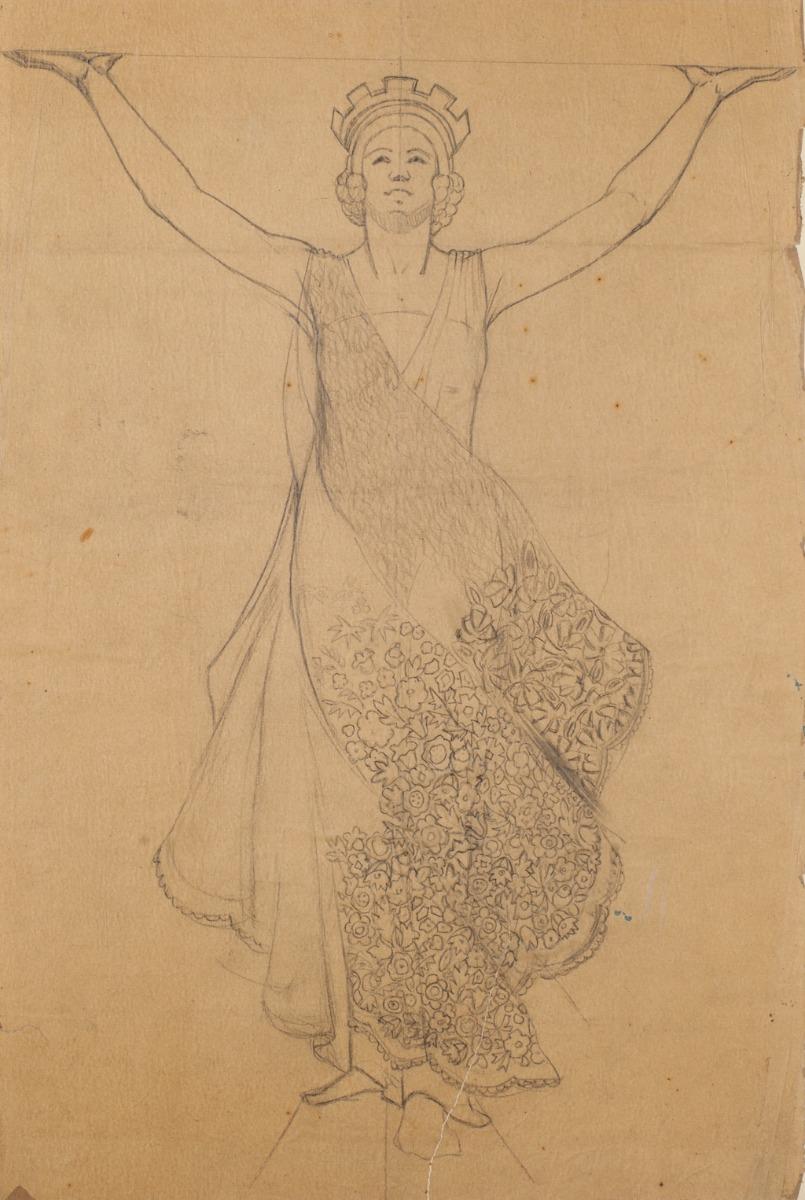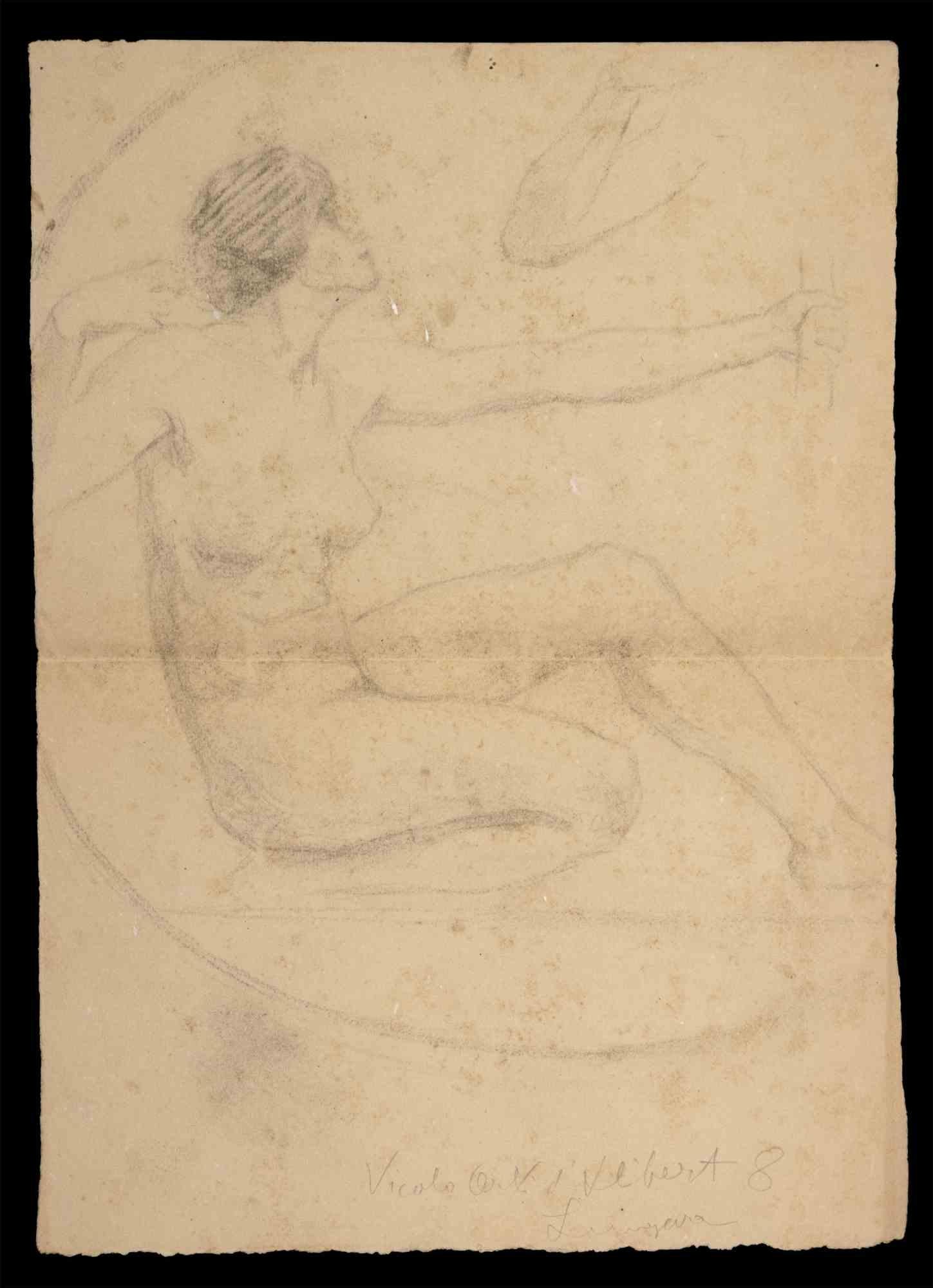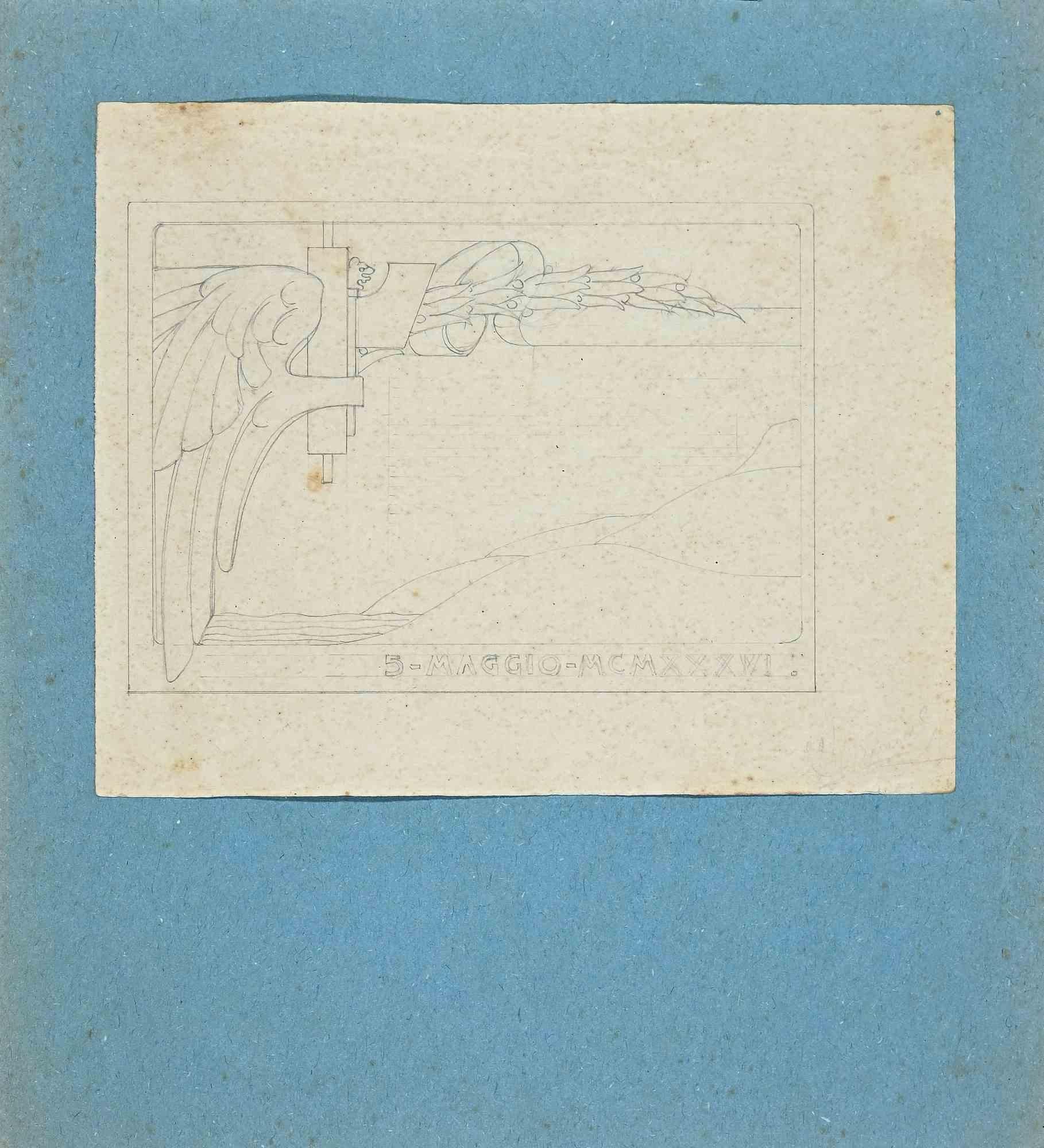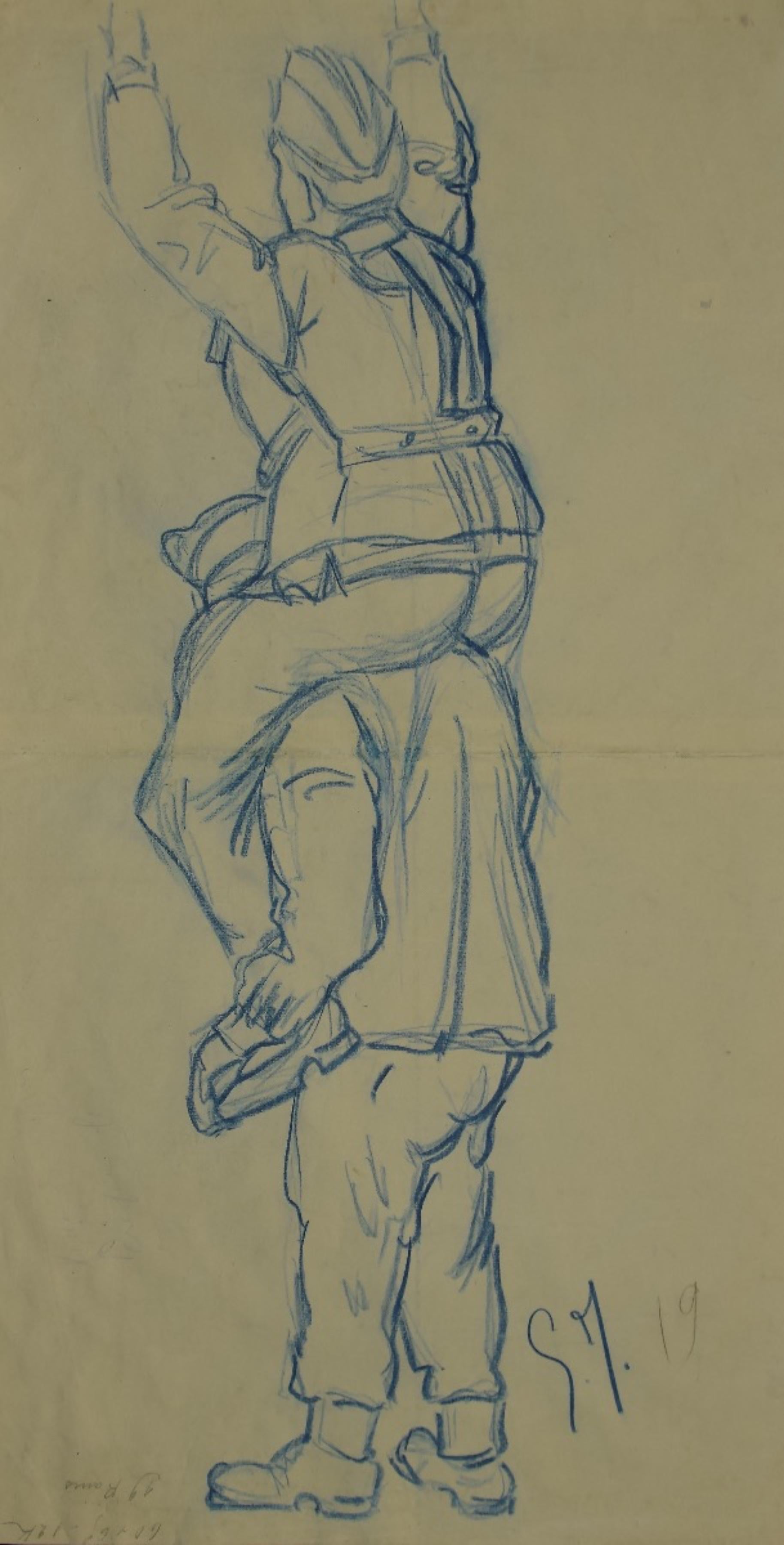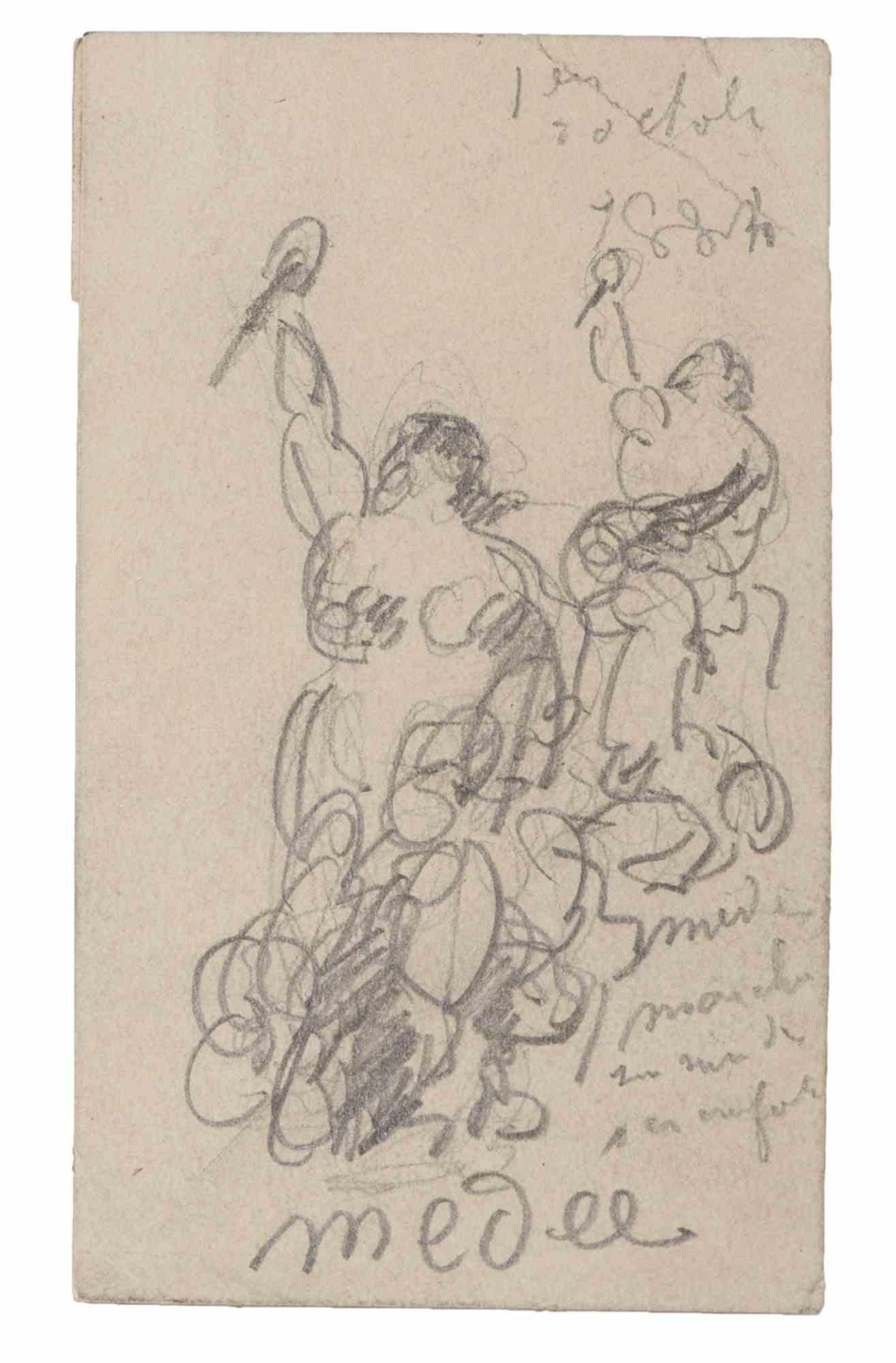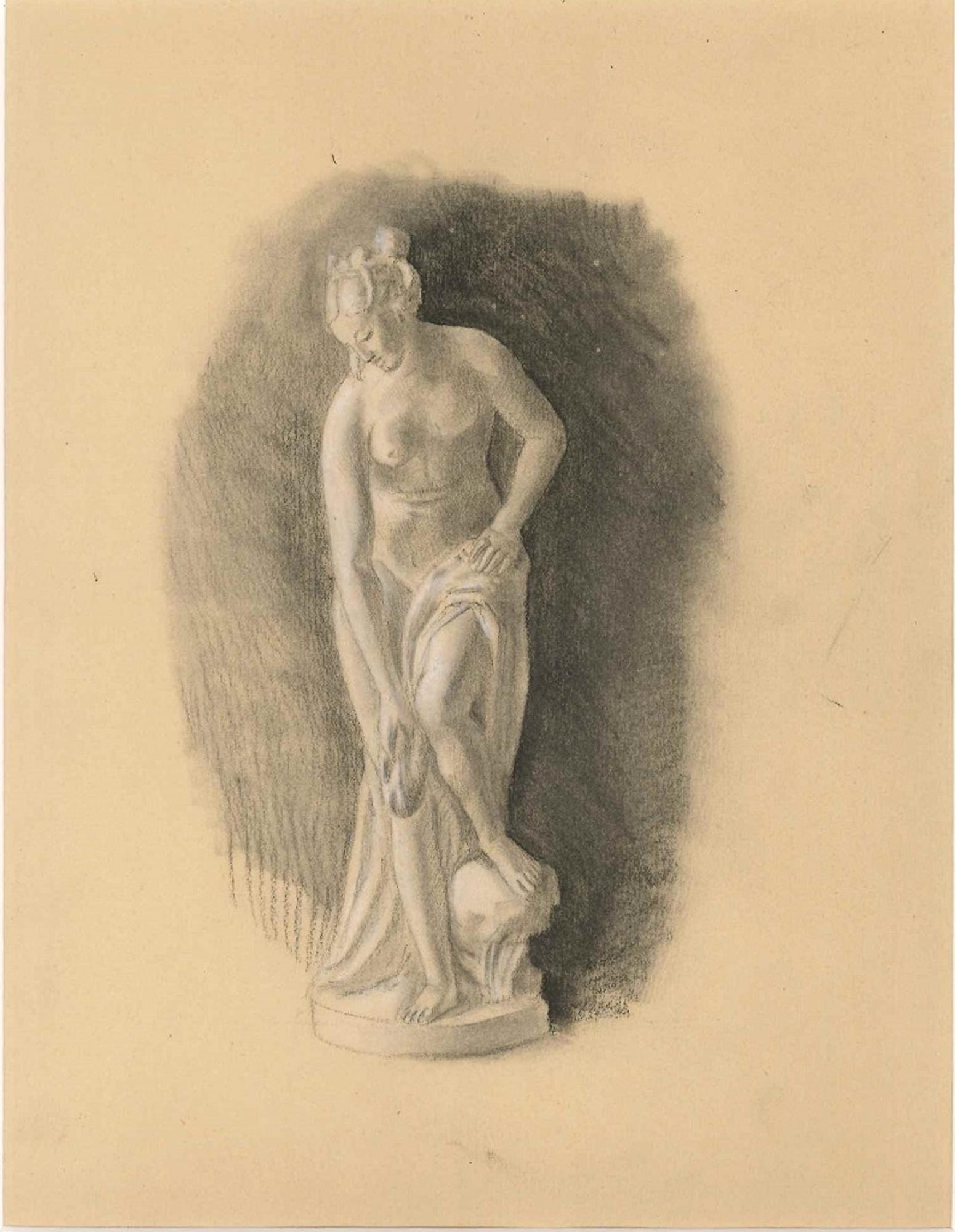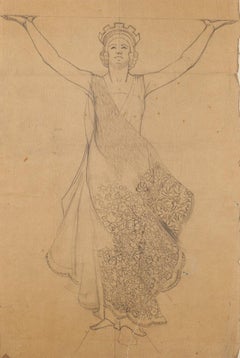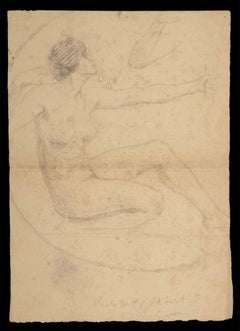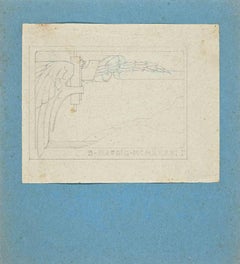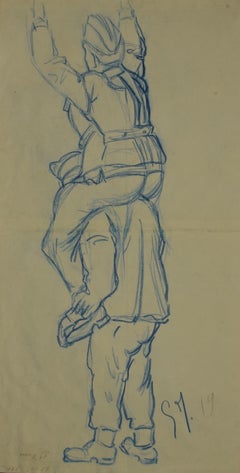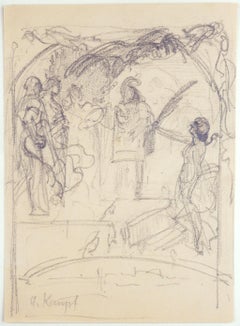Items Similar to Victory - Pencil and Pastel Drawing - Early 1900
Want more images or videos?
Request additional images or videos from the seller
1 of 6
UnknownVictory - Pencil and Pastel Drawing - Early 1900Early 20th Century
Early 20th Century
$952.39
£707.88
€800
CA$1,314.98
A$1,458.22
CHF 766.19
MX$17,816.95
NOK 9,586.03
SEK 8,998.12
DKK 6,091.60
About the Item
Victory is an original drawing in pencil realized by an Anonymous artist of the XX century.
Sheet dimension: 42 x 30 cm.
Good conditions with the traces of time, some small holes and stains on the margins.
The artwork represents a nude female beside a huge eagle, skillfully expressed through strong lines, presentation of magnificent victory.
- Creation Year:Early 20th Century
- Dimensions:Height: 16.54 in (42 cm)Width: 11.82 in (30 cm)Depth: 0.08 in (2 mm)
- Medium:
- Movement & Style:
- Period:
- Framing:Framing Options Available
- Condition:Insurance may be requested by customers as additional service, contact us for more information.
- Gallery Location:Roma, IT
- Reference Number:Seller: M-1079471stDibs: LU65036564302
About the Seller
4.9
Platinum Seller
Premium sellers with a 4.7+ rating and 24-hour response times
1stDibs seller since 2017
7,688 sales on 1stDibs
Typical response time: 3 hours
- ShippingRetrieving quote...Shipping from: Monaco, Monaco
- Return Policy
Authenticity Guarantee
In the unlikely event there’s an issue with an item’s authenticity, contact us within 1 year for a full refund. DetailsMoney-Back Guarantee
If your item is not as described, is damaged in transit, or does not arrive, contact us within 7 days for a full refund. Details24-Hour Cancellation
You have a 24-hour grace period in which to reconsider your purchase, with no questions asked.Vetted Professional Sellers
Our world-class sellers must adhere to strict standards for service and quality, maintaining the integrity of our listings.Price-Match Guarantee
If you find that a seller listed the same item for a lower price elsewhere, we’ll match it.Trusted Global Delivery
Our best-in-class carrier network provides specialized shipping options worldwide, including custom delivery.More From This Seller
View AllAllegory - Original Pencil on Paper - 20th Century
Located in Roma, IT
Figure is an original drawing in pencil on paper realized by an anonymous artist of the 20th Century.
Aged with cutaways on the margins.
The artwork represents the study of a figu...
Category
Early 20th Century Modern Figurative Drawings and Watercolors
Materials
Pencil
Nude - Original Drawing - Early 20th Century
Located in Roma, IT
Nude is an original drawing in pencil realized by an anonymous artist in the early 20th Century.
Good conditions except for fixings and consumed lower margin.
The artwork is depict...
Category
Early 20th Century Modern Figurative Drawings and Watercolors
Materials
Pencil
Sketch for a Bas-Relief - Original Drawing - Early 20th Century
Located in Roma, IT
Sketch for a Bas-Relief is an original artwork realized by the Unknown Artist in the early 20th Century.
Original pencil drawing on ivory-colored paper, glued on colored cardboard ...
Category
Early 20th Century Modern Figurative Drawings and Watercolors
Materials
Pencil
$250 Sale Price
40% Off
Soldiers - Pencil and Pastel - Mid-20th Century
Located in Roma, IT
Soldiers is an original pencil and pastels drawing on ivory-colorated paper, realized by Anonymous French Artist of the mid-20th Century.
In very good conditions. Image Dimensions:...
Category
Mid-20th Century Modern Figurative Drawings and Watercolors
Materials
Pencil, Pastel
Medée - Original Pencil Drawing - Early 20th Century
Located in Roma, IT
Medée (Medea killing her Childs) is an original drawing in pencil realized by an anonymous French artist of the early 20th century.
Hand-signed, illegible, very good conditions.
Sm...
Category
Early 20th Century Modern Figurative Drawings and Watercolors
Materials
Pencil
Venus - Original Pencil Drawing Early 20th Century
Located in Roma, IT
Venus is an original artwork realized by an Anonymous French artist in the first years of the Twentieth Century. Pencil on paper. Cardboard passepartout included (cm 49 x 34). Very good conditions.
The artwork represents a standing Venus figure realized in pencil. The artists uses chiaroscuro to define the volumes of the statue. The lit parts of the statue are realized with a white pencil. The artwork reproduces an ancient classical female sculpture on a base. The artwork is an academic study to represent the female anatomy...
Category
Early 20th Century Figurative Drawings and Watercolors
Materials
Pencil
You May Also Like
Disegno figurativo allegorico italiano stile Decò della prima metà del XX secolo
By Marcello Dudovich
Located in Florence, IT
Il disegno in questione rappresenta una figura figura femminile nuda in piedi con le braccia alzate, in una posa solenne come fiero è il suo sguardo, ai cui piedi sta sdraiata una fi...
Category
1930s Art Deco Nude Drawings and Watercolors
Materials
Paper, Color Pencil
Study for an allegory of victory / - A virtuoso victory -
By Arthur Kampf
Located in Berlin, DE
Arthur Kampf (1864 Aachen - 1950 Castorp-Rauxel), Study to an allegory of victory, around 1900. Pencil on paper, 21 cm x 18 cm, signed lower left "A. Kampf".
- slightly darkened, otherwise in good condition
- A virtuoso victory -
About the artwork
The vertical-format sketch illustrates a plateau to which a staircase leads up from the right. Arthur Kampf thus takes up a typical baroque disposition for the depiction of allegories. And indeed, a female figure climbs the steps to hand the palm of victory to a figure that is probably also female. Other persons standing on the plateau pay homage to her, whereby the figure on the left edge of the picture may represent a warrior.
The scene is framed by an ornamentally decorated arch field, which additionally emphasizes the allegorical-historical content of the depiction. An arch can also be seen under the staircase, suggesting that this may be a design for a supraport.
The sheet could have been created in the wake of Arthur Kampf's appointment in 1899 as head of the studio for history painting at the Berlin Art Academy. The drawing style, which only outlines the idea of the picture and yet is determined by concise lines, corresponds to the sketchiness of the Baroque and testifies to Arthur Kampfs intensive study of this heyday of history painting.
About the artist
Arthur Kampf was the son of the Aachen painter and imperial court photographer August Kampf. His older brother Eugen and his son Herbert were also painters.
Arthur Kampf studied at the Düsseldorf Academy of Art from 1879 under Eduard von Gebhardt and Peter Janssen the Elder, whose master pupil he was from 1883 to 1891. Influenced by the naturalistic paintings of Jules Bastien-Lepage, which Kampf saw on a trip to Paris in 1885, he created the painting "The Last Statement" in 1886, which was based on a personal experience. It shows a man mortally wounded by knife wounds. The oppressive drasticness of the almost life-size depiction caused a sensation and controversial criticism.
The first successes were achieved: At the Berlin Jubilee Exhibition of 1886, Kampf received an honorable mention, and at the Munich Annual Exhibition of 1890, he was awarded a gold medal. Between 1886 and 1936, Kampf participated in all the major German exhibitions.
In 1887 the artist painted his first fresco, which was the beginning of a series of monumental compositions. With the highly successful painting "The Burial of the Corpse of Kaiser Wilhelm I in the Berlin Cathedral" (1888), Kampf established himself as a painter of contemporary history, following in the footsteps of Adolph von Menzel, whose oeuvre he immediately took up with the painting "Speech by Frederick the Great to His Generals in Koeben" (1893). The pictures of his Liberation War cycle were included in school textbooks and distributed in large editions as postcards.
As for his academic career, Kampf became an assistant professor at the Düsseldorf Academy of Art in 1887, and in 1894 he was appointed professor of the class for antiquities and nature, and in 1897 he became head of the painting class. In 1899 Kampf was appointed director of the history painting studio at the Berlin Academy of Art. In 1901 he became a full member of the academy and was its president from 1907 to 1912. As Anton von Werner's successor, Kampf directed the Academy of Fine Arts in Charlottenburg from 1915 to 1925.
Among his monumental works is the painting of the assembly hall of the Aachen town hall, done between 1898 and 1902. It focuses on the social welfare of the state and the work of the people. Important subsequent commissions include the painting of the reading room of the new Royal Library in Berlin and the new auditorium of the University of Berlin with "Fichte's Speech to the German Nation". During World War I, at the request of General Ewald von Lochow, Kampf traveled to the Western theaters of war, including Warsaw in 1916.
In addition to painting, Kampf was also intensively involved in printmaking and, together with his brother Eugen and artist friends such as Alexander Frenz and Olof Jernberg, was considered an innovator of lithography in Düsseldorf. From 1913 on, he worked continuously as an illustrator of historical works and literary classics such as Shakespeare and Goethe.
Kampf remained a recognized artist after 1933. On the occasion of the retrospective of his complete works at the "Great German Art Exhibition", he was awarded the "Eagle Shield of the German Reich". During the final phase of World War II, Kampf was placed on Hitler's "Gottbegnadetenliste," which protected him from military service. After World War II, Kampf, whose work was largely destroyed, fell into obscurity.
Arthur Kampf belonged to numerous artists' associations. He was a member of the "Rheinisch-Westfälischer Künstlerbund", the "Society of German Watercolorists", the "Association of German Illustrators", the "Malkasten", the "Künstlerclub St. Lucas", the "Düsseldorfer Künstlerbund", the "Freie Vereinigung Düsseldorfer Künstler" and the "Berliner Künstlerbund".
Arthur Kampf's sister was married to the painter Alexander Frenz.
"Kampf's public recognition in the German Empire later led to his being one-sidedly labeled as a history painter and representative of the Wilhelmine era. This classification does not do justice to the artist's oeuvre as a whole. His early talent did not experience a rapid development later on, but it reached an ever greater mastery in the sense of an impressively relaxed realism and extended thematically beyond history. Kampf was also an excellent draughtsman, etcher and lithographer. Many of his works have been destroyed or lost, and some lead a shadowy existence in museum storerooms."
- Otto Zirk
"His importance as a Wilhelminian painter and cultural politician has been forgotten in favor of an exaggerated reception of his work during the Third Reich.
- Andreas Schroyen
Selection of public collections that own works by Arthur Kampf:
Altonaer Museum Hamburg, Berlinische Galerie, Burg Frankenberg Aachen, Busch-Reisinger Museum Cambridge/Mass., Deutsches Historisches Museum Berlin, Government Art Collection London, Kulturhistorisches Museum Magdeburg, Kunsthalle Hamburg, Museum für Kunst- und Kulturgeschichte Dortmund, Museum Kunstpalast Düsseldorf, Neue Nationalgalerie Berlin, Suermondt-Ludwig-Museum Aachen, Van der Heydt-Museum Wuppertal.
Selected Bibliography
Hans W...
Category
Early 20th Century Realist Figurative Drawings and Watercolors
Materials
Paper
$552 Sale Price
20% Off
Two divine women - Pencil drawing - circa 1914
By Georges Conrad
Located in Paris, IDF
Georges CONRAD (1874-1936)
Two divine women
Original pencil and color pencil drawing
Signed with the stamp of atelier
On paper 26.5 x 20 cm (c. 10,4 x 7.8 in)
Very good condition, ...
Category
1910s Academic Figurative Drawings and Watercolors
Materials
Carbon Pencil, Color Pencil
$238 Sale Price
33% Off
Victory Angel - Lithograph
By Niccolo dell'Abbate
Located in Paris, IDF
Niccolo dell'Abbate
Victory Angel, 1962
Lithograph after a drawing
On vellum 32 x 24 cm (c. 13 x 10 in)
Excellent condition
Category
1960s Realist Figurative Prints
Materials
Lithograph
Study of female nude and a couple - Pencil drawing - circa 1914
By Georges Conrad
Located in Paris, IDF
Georges CONRAD (1874-1936)
Study of female nude and a couple
Original pencil drawing
Signed with the stamp of atelier
On paper 26.5 x 20 cm (c. 10,4 x 7.8 in)
Good condition, paper...
Category
1910s Academic Figurative Drawings and Watercolors
Materials
Pencil
Spirit of Free Men
By Alexander Rosenfeld
Located in West Hollywood, CA
Presenting a monumental original graphite drawing by American artist Alexander Rosenfeld.
Rosenfeld was classically trained in Poland before set...
Category
1930s Art Deco Figurative Drawings and Watercolors
Materials
Pencil, Paper
Price Upon Request
More Ways To Browse
Pastel 1900
Antique Eagle Painting
Freedom Painting
Australia Art
Original Antique Engraving
French Blue Painting
Vintage 1997
Photographic Camera
Italian Engraving
Italian Etchings
Large Acrylic Abstract
Paris Etching
Vintage American Photos
Used Car
Mid Century Abstract Painting
Mid Century Abstract Paintings
Ethereal Art
Female Figurative Art
